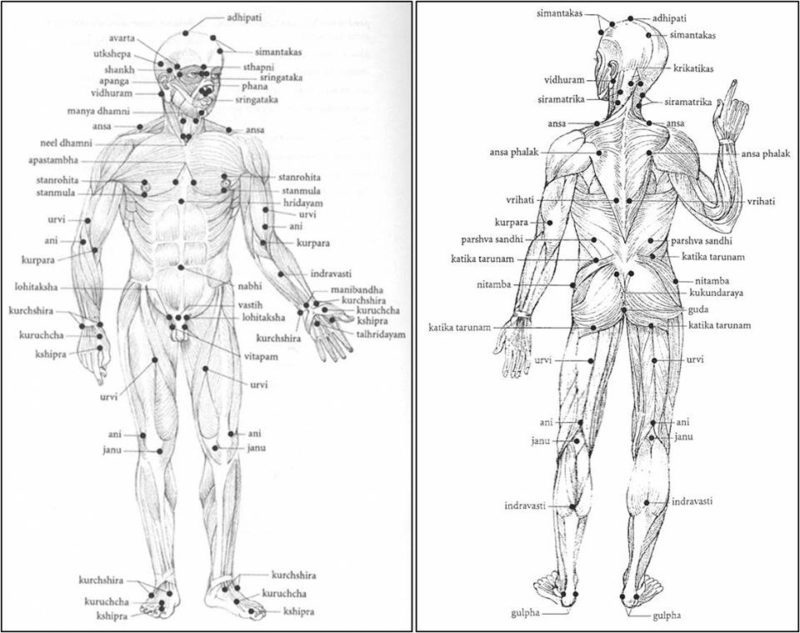 Marma Chikitsa is an ancient practice that involves applying pressure and intention to different points, or marmas, of the body which helps activate Prana and release pranic blockages throughout the Nadi system. Like the Nadis and Chakras, these marma points are made up of groups of blood vessels and veins, making them not only subtly significant, but physiologically significant as well.
Marma Chikitsa is an ancient practice that involves applying pressure and intention to different points, or marmas, of the body which helps activate Prana and release pranic blockages throughout the Nadi system. Like the Nadis and Chakras, these marma points are made up of groups of blood vessels and veins, making them not only subtly significant, but physiologically significant as well.
This practice originates from Kalaripayattu, the oldest form of martial arts that comes from South India, and is similar to the Meridian system and is one of the roots of acupuncture in Chinese medicine.
Marma & Ayurveda
Marma points create pathways that connect all layers of the body, gross and subtle, through the nervous system. We can study and analyze this in a way that connects key concepts of Ayurveda to physiological aspects of the body and subtle aspects of the mind:
MANO VAHA SROTA: PATHWAYS OF THE MIND
The Mano Vaha Srota is a continuously flowing consciousness that roots through the Heart, Brain, and Chakra system. The Mano Vaha Srota contains all aspects of an entire being, including everything gross and subtle and the 5 Koshas (bodily sheaths).
The Mano Vaha Srotas contain openings where energy pools and can be accessed through three things:
- The synaptic cleft (space between neurons)
- The Indriyas (sense organs)
- Marma points
MAJJA DHATU & MAJJA VAHA SROTA: THE NERVOUS SYSTEM
Majja Dhatu (or nervous tissue) is how marma points express themselves.
Majja Vaha Srota is the channel of the nervous system, rooting through the Brain and Spinal Cord. Majja Vaha Srota channels through the entire nervous system and intimately works with Majja Dhatu so that the nervous system can function.
Both Majja Dhatu and Majja Vaha Srota are platforms of Mano Vaha Srota. This can also be explained by understanding that the nervous system is a platform/structure for the flow and function of the mind.
We can thank the cooperation of these systems for our ability to perceive and cognitize our world.
Three subdoshas that help the function of the Mind:
- Tarpaka Kapha (memory)
- Sadhaka Pitta (cognition)
- Prana Vayu (sensory perception)
Marma Chikitsa
Treatment or practice on the Marmani of the body directly influence these aspects and allow the release and folw of Prana and Tejas through all layers of the body – subtle and physical. Marma chikitsa should not be practiced lightly, and requires a fair amount of experience and knowledge to conduct correctly. Please seek professional guidance before attempting to work with Marma.
Here are a few examples of Marma points throughout the body as they relate to the primary Chakras:
ADHIPATI MARMA
- Master of the Marmas
- Located at the crown of the head
- Extremely sensitive – severe injury causes death
- Increases efficiency of all other marmani
- Stimulates the pineal gland and aids in health of the nervous system
- Clears the mind
- Arises Santosha, or contentment
- Related to Sahasrara Chakra
STHAPANI MARMA
- Between the brows at the top of the bridge of the nose
- Stimulates the brain and focus
- Regulates the pituitary gland
- Balances all 3 doshas
- Activates unconscious intelligence and wisdom
- Related to the Ajna Chakra
NEELA MANYA MARMA
- Consists of two sets of marmani, located on either side of the trachea in the throat
- Aids in healthy function of the Thyroid and Parathyroid
- Aids in expression of speech and emotions
- Regulates Udana Vayu
- Related to Visshuda Chakra
HRIDAYA MARMA
- Center of the chest in the breast bone. Midway up between the sternum and base of throat
- Only stimulate during expiration (avoid putting pressure here on an inhalation)
- Stimulates cardiovascular function
- Aids in blood pressure
- Helps regulate thymus function o Aids in circulation (Vyana Vayu)
- Related to the Anahata Chakra
NABHI MARMA
- Navel point of the body where the umbilical cord detaches (the belly button)
- 4 fingers width
- In Ayurveda, this marma is home to the center of the veins and blood vessels in the body (because of its relation to the umbilical cord in utero)
- Connected to the Kandasthana (central origination point of the Nadis)
- Connective center of the umbilical cord in the womb – transference of nutrition and emotions via the mother.
- Vital marma point – severe injury can cause death
- Aids digestive fire (jatharagni)
- Alleviates constipation when stimulated
- Releases deep rooted emotional traumas
- Related to the Manipura Chakra
BASTI MARMA
- Located in the abdomen, in the pelvic cavity, where the bladder sits
- Controls bladder/urinary tract function
- Aids in regulation of gonadic function (ovary and testicular health)
- Can be damaged by stones (kidney stones) or infection (UTI/bladder infection)
- Alleviates urinary blockages and Apana Vayu blockages
- Related to the Svadisthanna Chakra
GUDA MARMA
- Located at the anus
- Controls expelling of fecal matter and waste from the body
- Regulates Apana Vayu
- Root of vital energy and contentedness
- Damaged or aggravated by lower GI issues such as irritable bowel syndrome or constipation
- When stimulated helps relieve these issues^
- Related to the Muladhara Chakra